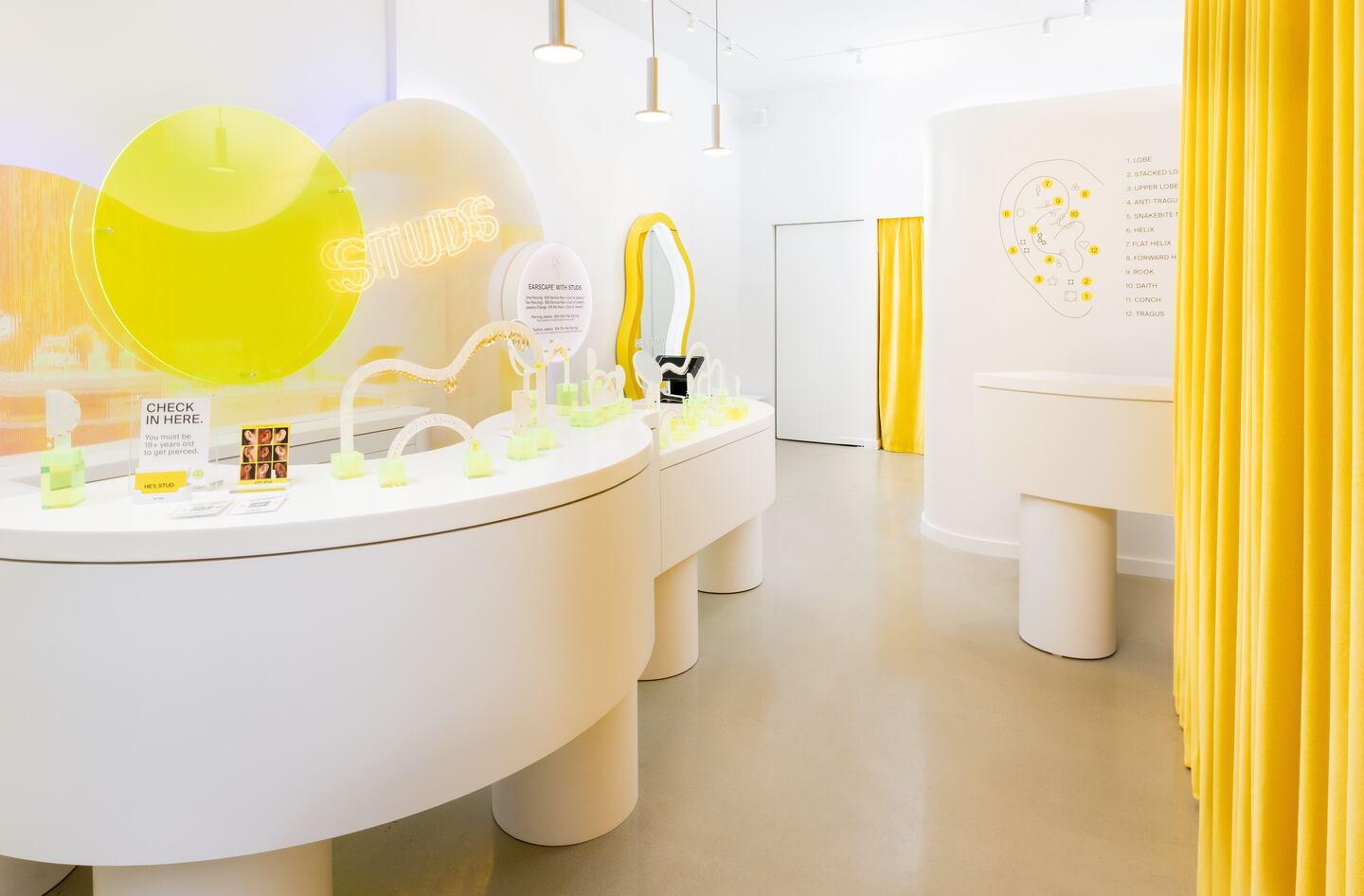
The Business of Fashion
Agenda-setting intelligence, analysis and advice for the global fashion community.

Agenda-setting intelligence, analysis and advice for the global fashion community.

On the surface, Studs looks like countless other direct-to-consumer jewellery brands that have popped up on your Instagram feed in the last few years, down to the boldface, sans-serif font and moderately priced, gold-plated hoops and chains.
But the three-year-old company’s success is tied to a very offline goal: to make ear piercing cool again. The brand launched in 2019 with an e-commerce site, but also a store on the border of Manhattan’s Soho and Lower East Side, where it offered the neighbourhood’s fashionable clientele the option to get their ears pierced with a single-use sterilised needle instead of the typical gun used at mall accessory stores and big-box retailers.
The new twist on a routine service, combined with stylish-yet-affordable jewellery was a hit. Studs, which has raised about $30 million from venture firms including Thrive Capital, now operates 14 stores in major cities including New York City, Los Angeles, Boston, Miami and Austin.
A typical outpost serves as a billboard for the brand, enticing customers into a space bathed in neon lights with playful, punny signage (“hey, stud,” reads a mirror sign in the company’s Upper East Side location). The goal is to get each visitor to stay for a piercing and leave with at least one piece of jewellery. It costs less to acquire new customers this way than to attract them with online advertising, said Lisa Bubbers, Studs’ co-founder and chief brand officer. Those customers tend to be more loyal, too.
ADVERTISEMENT
“We think of ourselves as a retail services company,” she said. “Our stickiness is the piercing service.”
Studs is one of a growing number of direct-to-consumer brands that sees in-person services as the next big market to disrupt. With Instagrammable outposts and savvy branding (Studs has embraced the term “earscaping”), they promise an experience customers can’t get elsewhere, even if the service itself is hardly revolutionary.
Eyewear brand Warby Parker helped usher in this new wave of retail when it introduced eye exams in its physical stores in 2013 (it now offers this service in over 100 locations). Facegym started with facial massages and is on pace to generate roughly half its sales from skin care products this year. Feit, which sells hand-sewn shoes, is one of a number of brands offering in-store repair services.
The up front cost of opening a store is high. But customers who visit one of these start-ups’ stores for a facial treatment or an eye exam tend to spend more on products as well, making these establishments more reliable money makers than purely online retail.
“It’s more profitable to get someone to your store to buy,” said Laura Barr, senior vice president of retail and consumer at brokerage CBRE. “If you have a service that requires customers to come to a store, that is a great way to drive traffic.”
Service-oriented stores are a subset of a wider trend where digital-first brands are going all-in on physical retail. Many are doing so after failing to build profitable businesses online; the costs of finding new customers via social media ads keeps rising, and cultivating brand loyalty has proven difficult.
Warby Parker, which pioneered the digital first direct selling model when it launched its online store in 2010, has provided a template for providing real-world services as well. The company opened its first standalone store in New York in 2013, with pristine built-in shelves filled with stylish eyeglasses and books. By 2019, Warby Parker’s stores accounted for 65 percent of the brand’s overall sales.
The eye exams, which cost $85 or more depending on customers’ vision insurance, contributed less than two percent of the brand’s revenue in 2021. (Some customers’ insurance fully cover the exams). But they are valuable beyond that direct sales bump.
ADVERTISEMENT
“What we’ve observed is, a higher conversion rate from stores where we employed an eye doctor to customers and making a product purchase,” Warby Parker’s chief financial officer Steve Miller said on an earnings call in August. (“Introducing eye exams was critical to the evolution of our brand when we launched physical retail and continues to be a core business offering,” the company said in an emailed statement. “By investing in eye exam suites, alongside our other vision services, we’re continuing to provide more value to our customers over time.”)

Other brands built in a physical services component from the start.
Facegym launched as a concession shop in Selfridges in 2016, offering a hyperactive version of facials called workouts, where trained associates in athletic gear manipulate the muscles in a person’s face using tools like anti-aging rollers and a contouring sculptor.
Inge Theron, the company’s founder and creative director, said her original ambition was to become the “Soul Cycle of beauty.” Facegym now operates 15 studios in the UK and US, where about half of its customers go for sessions that range from $65 to $300. In 2017, the company began selling third-party skin care products, and launched its own line in 2020.
This year, sales are on track to be roughly evenly split between treatments and the brand’s serums, face oils and moisturisers, and are projected to hit $16 million in 2022. While Facegym does brisk business online, it relies on those facial workouts to drive skin care sales. About 70 percent of customers that buy Facegym’s skin care products visited the studio first, Theron said.
“It was essential for us to have these spaces,” Theron said. “Unless we created this experience, it wouldn’t really land.”
Three more locations are planned to open by the second half of next year.
Studs’ stores also breed loyalty among its most avid consumers.
ADVERTISEMENT
The company’s piercing service, which starts at $65 and includes a piercing and the purchase of an earring to fill the hole, also leads to repeat visits. Bubbers said about 40 percent of customers that get a piercing come back to Studs for another piercing or to buy more jewellery within their first year. Most of those customers who get piercings come back to the store and spend more per transaction, she added.
Building out a brick-and-mortar store network isn’t cheap. Facegym spends hundreds of thousands of dollars on average to build out its studios, replete with plush spa recliner chairs, quartz-like countertops made out of recycled Chobani lids and Skin IV machines that trainers use for advanced face workouts.
Still, Facegym is EBITDA profitable in all of its stores, Theron said. Warby Parker says it is able to recover the funds it uses to open each location in under 20 months on average.
Studs says its stores typically earn back their opening costs in under a year.
The extra cost is offset by the lower customer acquisition costs, Bubbers said.
“The stores do not require a lot of marketing dollars,” Bubbers said. Studs uses content on social media—such as short videos on types of piercings from professional piercers—and celebrities like Kaia Gerber to spread the word about its retail locations.
Generating profits on a four wall basis—which accounts for sales generated in the store minus the costs to make that sale— doesn’t mean a company is profitable overall. Warby Parker ended the first half of the year with $66 million in losses, up from around $7 million in losses during the same period a year prior. Studs has yet to turn a profit on its overall business either, Bubbers said.
Recruiting talent is one of the biggest challenges of a store-based strategy, Theron said.
“It’s tough work – you have to sculpt people’s faces into submission,” she said. “There isn’t a huge talent pool but a lot of demand for it.”
Rents plummeted during the pandemic, allowing brands to open thousands of new stores this year. But on the hottest streets, the deals are over and bidding wars have begun.
Retailers are opening new locations at their fastest pace in years as shoppers visit stores again in numbers rivaling 2019 levels.
Amid an ongoing 'retail apocalypse' that’s wiping out thousands of stores, retailers are staking their future on a new generation of brick-and-mortar shops that are radically different from their predecessors.

Malique Morris is Direct-to-Consumer Correspondent at The Business of Fashion. He is based in New York and covers digital-native brands and shifts in the online shopping industry.
Apparel start-ups founded on the promise of offering men the perfect T-shirt are proving resilient in an otherwise dreary DTC sector rampant with fire sales, bankruptcies and steep revenue declines.
Apparel brands Knot Standard and Billy Reid are teaming up in a move investors say we may see more of as fashion start-ups seek alternative funding routes to grow their businesses.
Warby Parker, Everlane and other brands are partnering with small, but buzzy fashion labels as an inexpensive way to find new customers, and regain some status with shoppers who have moved on.
The embattled athleisure brand has mounting cash problems, Sourcing Journal says.